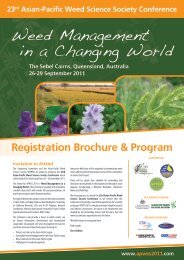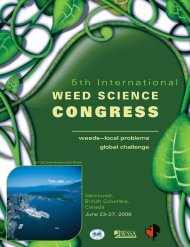PARAQUAT
PARAQUAT
PARAQUAT
Create successful ePaper yourself
Turn your PDF publications into a flip-book with our unique Google optimized e-Paper software.
Emetic<br />
PP796, 2-amino-4, 5-dihydro-6-methyl-4-propyls-triazole-[1,5-a]pyrimidin-5-one<br />
(FAO 2008)<br />
Its molecular formula is: C 9 H 13 N 5 O. No<br />
information could be found about its health<br />
effects other than causing vomiting.<br />
Contaminants<br />
Free 4,4’-bipyridyl; terpyridines (FAO 2008)<br />
4,4’-bipyridyl is the precursor of paraquat and<br />
there is evidence linking it to skin cancer (see<br />
Toxicology, Cancer). Little information appears to<br />
be available on the health effects of terpyridines.<br />
1.3 Metabolites<br />
Paraquat is excreted largely unmetabolised,<br />
along with small quantities of monoquat (1.9%),<br />
paraquat monopyridone (3.2%), and paraquat<br />
dipyridone (1.1%) (INCHEM 1986).<br />
1.4 Mode of action in weeds<br />
Paraquat is a fast-acting, non-selective<br />
contact herbicide that is absorbed by the<br />
foliage. It destroys plant tissue by disrupting<br />
photosynthesis and rupturing cell membranes,<br />
which allows water to escape leading to rapid<br />
desiccation of foliage (Dinis-Olivera et al 2006).<br />
It can also be translocated within the plant,<br />
increasing the likelihood of residues.<br />
1.5 Uses<br />
Paraquat is used as a herbicide, desiccant,<br />
defoliant, and plant growth regulator (US EPA<br />
1997). It is used for controlling broadleaf weeds<br />
and grasses in more than 100 different crops,<br />
including plantations (Paraquat Information<br />
Centre 2010a). According to industry sources,<br />
between 1995 and 2001 3.9% of total global<br />
sales were to oil palm plantations, 3.1% to<br />
banana plantation and 2.5% to tea estates – in<br />
all 9.5% of total sales to just 3 plantation crops<br />
mainly in developing countries (Gochez 2009).<br />
Other major crop uses are for maize, orchards,<br />
soybeans, vegetables, potatoes, rice, and cotton.<br />
It is used for wheat, apples, oranges, coffee,<br />
cocoa, and rubber. It is used as a pre-harvest<br />
defoliant or desicant on crops such as cereals,<br />
cotton, beans, hops, sugar cane, pineapple, soy,<br />
potatoes, and sunfl owers; and as a post-harvest<br />
desiccant to speed up removal of spent plants<br />
such as tomato plants. It is applied to pine trees<br />
to induce turpentine production. Paraquat is<br />
employed in no-till agriculture, killing grasses and<br />
weeds to minimise ploughing and help prevent<br />
soil erosion. It is used for weed control in nonagricultural<br />
areas such as roadsides, airports,<br />
around commercial buildings, drains, irrigation<br />
ditches, and waterways. It has been employed<br />
for killing illegal marijuana crops in the U.S. and<br />
in Mexico. It has also been reported as used in<br />
shrimp and prawn farming (PAN UK 2003).<br />
Most use takes place in developing countries,<br />
where the conditions of use (hot often humid<br />
climate, lack of protective clothing, leaking<br />
equipment, continuous use, lack of control over<br />
the workplace, lack of awareness of hazard, and<br />
lack of medical facilities) make its use particularly<br />
hazardous.<br />
Paraquat is now being promoted as an<br />
alternative to glyphosate to overcome the<br />
increasing problem of glyphosate resistance in<br />
countries with widespread use of Roundup on<br />
GM crops (Paraquat Information Centre 2010b).<br />
In the US paraquat is recommended for use in<br />
conservation tillage programmes, mixed with up<br />
to 3 other herbicides, each with a different mode<br />
of action, because of the advent of superweeds<br />
like Palmer amaranth (Ho 2010).<br />
Paraquat is also put to a number of illegal uses.<br />
It is believed to have been used to catch mud<br />
lobsters in Fiji, which were linked to the death<br />
of a woman who consumed some (Fiji Times<br />
2010a).<br />
1.6 Manufacturers<br />
Syngenta (formerly Zeneca, ICI), the world‘s<br />
largest agrichemical corporation, is the major<br />
manufacturer (with plants in UK and China),<br />
selling the product under the trade name<br />
Gramoxone. It is produced in many other<br />
countries under different trade names.<br />
China is reported to be the world’s largest<br />
manufacturer of paraquat, and production is<br />
5




